THE
EVERYTHING
SOUP, STEW, & CHILI
COOKBOOK Dear Reader, Writing this cookbook has been a happy adventure. Usually, when I share the subject of an in-progress cookbook with family and friends, they demand recipes. Or cooking tips. However, when I told people I was writing The Everything Soup, Stew, & Chili Cookbook , the tables turned. Instead of asking for recipes, everyone wanted to give me recipes. Over and over I heard, My grandmas chicken soup is the absolute best or Here, youve just got to include my rabbit stew or My uncle gave me his green chili recipeyouve never tasted anything so good! Of course, most of the recipes shared were more like compass points than actual roadmaps.
Thats because soups, stews, and chilies are among the most flexible and personal of dishes. The same recipe can vary based on the mood of the cook, the availability of fresh ingredients, the amount of liquid added, and the time available for simmering. Having been raised on my mothers heirloom gumbo and fricassee recipes and my fathers ever-evolving chili pot, I can attest to the joy of anticipating the nuances of every batch. In this book youll find recipes that represent the culinary heart of many different cultures. One cooks strange new curry is anothers family comfort food. Follow the recipes as given or use them as a starting point for your own explorations.
Either way, my great hope is that youll find recipes youll embrace and want to share.  Welcome to the EVERYTHING Series! These handy, accessible books give you all you need to tackle a difficult project, gain a new hobby, comprehend a fascinating topic, prepare for an exam, or even brush up on something you learned back in school but have since forgotten. You can choose to read an Everything book from cover to cover or just pick out the information you want from our four useful boxes: e-questions, e-facts, e-alerts, and e-ssentials. We give you everything you need to know on the subject, but throw in a lot of fun stuff along the way, too. We now have more than 400 Everything books in print, spanning such wide-ranging categories as weddings, pregnancy, cooking, music instruction, foreign language, crafts, pets, New Age, and so much more. When youre done reading them all, you can finally say you know Everything !
Welcome to the EVERYTHING Series! These handy, accessible books give you all you need to tackle a difficult project, gain a new hobby, comprehend a fascinating topic, prepare for an exam, or even brush up on something you learned back in school but have since forgotten. You can choose to read an Everything book from cover to cover or just pick out the information you want from our four useful boxes: e-questions, e-facts, e-alerts, and e-ssentials. We give you everything you need to know on the subject, but throw in a lot of fun stuff along the way, too. We now have more than 400 Everything books in print, spanning such wide-ranging categories as weddings, pregnancy, cooking, music instruction, foreign language, crafts, pets, New Age, and so much more. When youre done reading them all, you can finally say you know Everything !  Answers to
Answers to
common questions  Important snippets
Important snippets
of information  Urgent
Urgent
warnings  Quick
Quick
handy tips PUBLISHER Karen Cooper DIRECTOR OF ACQUISITIONS AND INNOVATION Paula Munier MANAGING EDITOR , EVERYTHING SERIES Lisa Laing COPY CHIEF Casey Ebert ACQUISITIONS EDITORS Katie McDonough, Katrina Schroeder SENIOR DEVELOPMENT EDITOR Brett Palana-Shanahan EDITORIAL ASSISTANT Hillary Thompson EVERYTHING SERIES COVER DESIGNER Erin Alexander LAYOUT DESIGNERS Colleen Cunningham, Elisabeth Lariviere, Ashley Vierra, Denise Wallace Visit the entire Everything series at www.everything.com
THE
EVERYTHING
SOUP , STEW ,
&CHILI
COOKBOOK
Belinda Hulin
 Copyright 2009 by F+W Media, Inc.
Copyright 2009 by F+W Media, Inc.
All rights reserved.
This book, or parts thereof, may not be reproduced in any form without permission from the publisher; exceptions are made for brief excerpts used in published reviews. An Everything Series Book.
Everything and everything.com are registered trademarks of F+W Media, Inc. Published by Adams Media, a division of F+W Media, Inc.
57 Littlefield Street, Avon, MA 02322 U.S.A.
www.adamsmedia.com ISBN 10: 1-60550-044-5
ISBN 13: 978-1-60550-044-7
eISBN: 978-1-60550-699-9 Printed in the United States of America. J I H G F E D C B A Library of Congress Cataloging-in-Publication Data
is available from the publisher. This publication is designed to provide accurate and authoritative information with regard to the subject matter covered. It is sold with the understanding that the publisher is not engaged in rendering legal, accounting, or other professional advice.
If legal advice or other expert assistance is required, the services of a competent professional person should be sought. From a Declaration of Principles jointly adopted by a Committee of the
American Bar Association and a Committee of Publishers and Associations Many of the designations used by manufacturers and sellers to distinguish their products are claimed as trademarks. Where those designations appear in this book and Adams Media was aware of a trademark claim, the designations have been printed with initial capital letters. This book is available at quantity discounts for bulk purchases.
For information, please call 1-800-289-0963.
To my daughter Sophie and son Dylan, who
never tire of helping me stir the pot. Contents Acknowledgments Many thanks to my friends at Adams Media for their encouragement and guidance.
In particular, Id like to thank project editors Katrina Schroeder and Katie McDonough, development editor Brett Palana-Shanahan, copy editor Sheila Elmosleh, and managing editor Lisa Laing. Bob Diforio has been a wonderful advocate, for which I am ever grateful. Hugs and kisses to my husband, Jim Crissman, who sampled my recipes, listened to me whine, and, when the bubbling pots got to be too much, took the family fishing. The Cast Iron Literary Circle of the Jacksonville Beachesparticularly authors Ruth Chambers and Carol ODellhave my devotion for their no-nonsense advice and unfailing moral support. Thanks to Robin Warshaw for sanity checks. And finally, merci beaucoup to my mother, Audrey Hulin, whose wonderful gumbo, vegetable soup, and touffe are forever imprinted on my taste buds.
Introduction THINK OF IT AS comfort in a bowl. Soups, stews, and chilies certainly provide an economical source of nourishment. But these creations are so much more than the sum of their ingredients. No two batches can be exactly alike because each carries the terroir the flavor signaturesof its components, captured at the moment of preparation. In addition, each version of a soup, stew, or chili recipe is influenced by the whim, the mood, the loving hands of the cook. A good recipe can ensure a good dish, but it cant predict the grace notes added by time, place, and human expression.
A bumper crop of fresh zucchini, a particularly fragrant bunch of basil, a dish of savory leftover pot roast; such variables are what make any slow-simmered jumble of ingredients a wonderful, original work of art. Anthropologists quibble over where and when the first pot of soup or stew appeared. Some credit the Neanderthals with softening foods in water in a hollowed bit of bark. Others note later evidence that African and European tribes learned to cook meat and plants together in the sealed stomach cavities of animals, while South American tribes used hollowed turtle shells as soup and stew vessels. Purists date the first real soups and stewsand in South America, where peppers were thrown in, chiliesto around 10,000 b.c., when ceramic pots appeared on the scene. References to soups and stews appear in the earliest surviving cookbooks, including some dating to the third century.
By the Middle Ages, sages and essayists were recommending chicken soup as a cure for all manner of infirmities. Early American writings on food trace recipes and soup customs with English, German, and French origins. Added to that early melting pot were offerings from Native Americans featuring tree nuts and wild greens. Journal entries from the colonial period make clear that soup, then as now, was considered a community-building dish that required both generosity and sharing. Soup became a lifesaving elixir during the Great Depression. Beginning in 1929, churches and charities opened makeshift dining halls serving hot soup and bread to anyone who lined up for a meal.
Next page




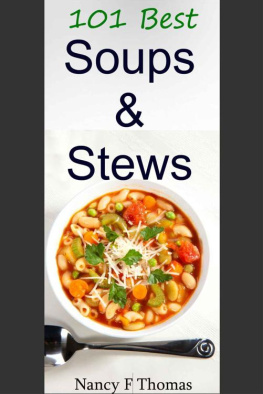


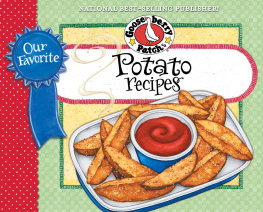
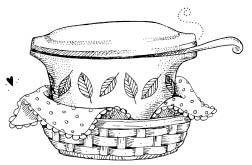
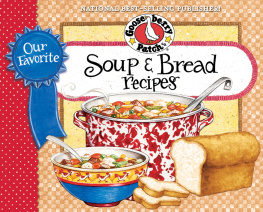

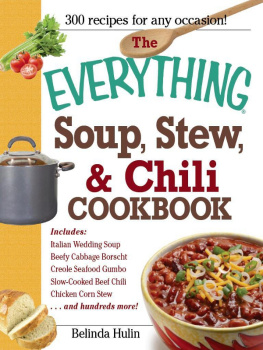
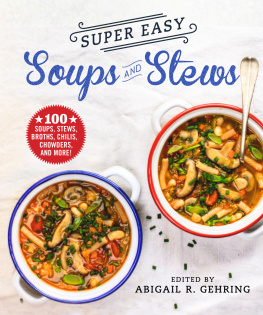
 Welcome to the EVERYTHING Series! These handy, accessible books give you all you need to tackle a difficult project, gain a new hobby, comprehend a fascinating topic, prepare for an exam, or even brush up on something you learned back in school but have since forgotten. You can choose to read an Everything book from cover to cover or just pick out the information you want from our four useful boxes: e-questions, e-facts, e-alerts, and e-ssentials. We give you everything you need to know on the subject, but throw in a lot of fun stuff along the way, too. We now have more than 400 Everything books in print, spanning such wide-ranging categories as weddings, pregnancy, cooking, music instruction, foreign language, crafts, pets, New Age, and so much more. When youre done reading them all, you can finally say you know Everything !
Welcome to the EVERYTHING Series! These handy, accessible books give you all you need to tackle a difficult project, gain a new hobby, comprehend a fascinating topic, prepare for an exam, or even brush up on something you learned back in school but have since forgotten. You can choose to read an Everything book from cover to cover or just pick out the information you want from our four useful boxes: e-questions, e-facts, e-alerts, and e-ssentials. We give you everything you need to know on the subject, but throw in a lot of fun stuff along the way, too. We now have more than 400 Everything books in print, spanning such wide-ranging categories as weddings, pregnancy, cooking, music instruction, foreign language, crafts, pets, New Age, and so much more. When youre done reading them all, you can finally say you know Everything !  Answers to
Answers to Important snippets
Important snippets Urgent
Urgent Quick
Quick Copyright 2009 by F+W Media, Inc.
Copyright 2009 by F+W Media, Inc.